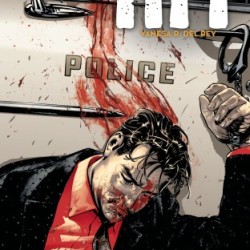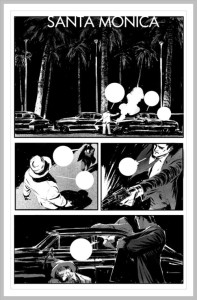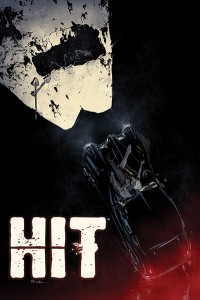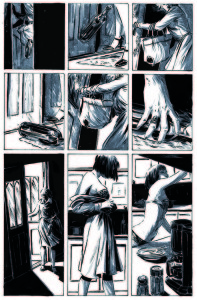A captivating crime noir miniseries, “HIT!” released by BOOM Studios!

 Vanesa Del Rey’s artwork is a breath of fresh air for her originality and adaptive style, panel-by-panel. Her depictions of 1950s LA is like seeing it on film and veers us from one scene to the next with cinematic visual storytelling. Del Rey’s panel layouts flow smoothly, producing natural emotions, which we can react to as if we took her hand to experience the story’s environment in America’s past era.
Vanesa Del Rey’s artwork is a breath of fresh air for her originality and adaptive style, panel-by-panel. Her depictions of 1950s LA is like seeing it on film and veers us from one scene to the next with cinematic visual storytelling. Del Rey’s panel layouts flow smoothly, producing natural emotions, which we can react to as if we took her hand to experience the story’s environment in America’s past era.BRYCE CARLSON: The idea first came to me while listening to a former LAPD officer tell stories of his time on the force. Once he started talking about “hit squads”, my brain couldn’t stop spinning and that’s how HIT was born. The story evolved over the course of a couple years but I knew pretty early on what themes and character development I wanted to explore. Some plot points and characters came and went but the core ideas stayed relatively intact.
2) Vanesa, how did you get involved with the project as penciler, for the series?
VANESA R. DEL REY: I was found! The awesome Dafna Pleban, an editor at BOOM!, found my work online and emailed me about testing for a series. I wasn’t picked to work on the project she was the editor for, but she referred me to Eric and Bryce. I turned in a sample for HIT issue #1 and they loved it!
3) How did you two usually start working on each issue? What was the procedure like from the writing process to the penciling stage?
BC: I scripted the entire series ahead of time but once Vanesa came on to the project, I had a chance to make some changes so each script was tailored to her style. Eric Harburn, our editor, is amazing and helped make the process incredibly smooth. Vanesa’s layouts would come in, I’d go over them with Eric, we’d give feedback, and then Vanesa would move on to drawing pages. It was important to me that Vanesa have the freedom to “go off script” and draw parts of the story in the way she saw it in her head, and when that happened, I was happy to adapt and tweak the script to make sure it worked as well as possible with the art. HIT was a team effort and I think that’s why it turned out as good as it did.
VRDR: It was a very trusting relationship. I read the script many times and came up with the compositions or scenes regardless sometimes of what was written. Bryce and Eric were very open to my ideas and suggestions. Having that freedom was amazing for me! It gave me the chance to experiment with the medium.
4) When I read the HIT series, I was easily led into this world that allured me with an authentic setting, connective characters, and compelling story. What connection did you want the readers to have with these characters? What research and information did you both discover, to give this series its organic content?
BC: Making a connection for readers with a protagonist who kills people and a cast of characters who are aren’t necessarily good people is not an easy thing. My intent was for readers to see this as a series about Slater and the people closest to him in his twisted life, a story about dealing with his messed up “family.” At the same time, I wanted HIT to feel real and cohesive with real 1955 Los Angeles. I spent years in the research and development phase and always kept the door open for real events to inform the story I was telling, which is what I would attribute to helping HIT feel organic.
 VRDR: I researched mostly environments, from architecture to furniture…Even the car toy in issue #4. I think those details make the world we’re creating more alive. But then there is the acting, facial expressions, mannerisms, body language that make these characters come alive on the page. I watched quite a few great films during the research stage!
VRDR: I researched mostly environments, from architecture to furniture…Even the car toy in issue #4. I think those details make the world we’re creating more alive. But then there is the acting, facial expressions, mannerisms, body language that make these characters come alive on the page. I watched quite a few great films during the research stage!
5) What were the most challenging things that both of you encountered while making HIT? What have you learned after taking this creative journey, and how has it empowered your experience as writer and artist?
BC: There were a lot of challenges. In particular, keeping the story as simple as possible was extremely tough. I have old outlines where the story is super complicated and stacked with even more characters. When it comes to noir, it’s easy for stories to become convoluted and confusing so I spent a lot of time making sure HIT was layered but accessible at the same time. Since this is my first creator-owned original series, I learned how to creatively work hand-in-hand with an artist and I have to say, it’s one of the best experiences I’ve ever had.
VRDR: HIT as a project was a challenge for me because my only experience with sequential work, back then, had been with storyboarding and short form stories. I decided to dive in precisely because it was a challenge. I definitely learned a lot about making comics and working in this industry. The project gave me the chance to experiment with the medium and have fun, Bryce and Eric made that journey a pleasure.
6) Why did you choose HIT to be the story that you want to tell? Did this come from any personal experiences? Had it been the interest of crime stories?
BC: I’m a longtime fan of the genre so a HIT was a natural direction for me. There are other genres I’m fond of but crime noir was my first love so it’s only fitting that’s where I ended up.
7) Does this particular story share any relevancy with today’s LA Police Departments? What effect do you believe this story would have on actual law enforcement employees that read HIT?
BC: HIT is a story about the LAPD before it had its deadliest unit, the Special Investigations Section, which was formed in 1965 and is still active today. The narrative I’ve attempted to weave is what happened between 1955 and 1965 to create such a deadly unit. I see a world where the LAPD is entertained by the events of HIT, but I also see a world where they take me out one night when I’m walking alone in my neighborhood.
8) What are your views about vigilante justice? If you were a cop during 1950s Los Angeles, how would you enforce the law, where crime corrupts the moral principals of powers that are responsible for preventing crimes?
BC: That’s a tough one because I really like Batman. I’m not a proponent of vigilantism but I also don’t believe in standing by idly when help is desperately needed and there’s an opportunity to provide it. If I were a cop in the ‘50s, I’d probably smoke a lot and drink even more. When it comes to the job, I’d do my best. I could say that I’d do things a certain way and stick to the straight and narrow, but that would be a bit audacious. The times affect you; they change you.
9) The criminal actions, which the villains carry out are pretty crafty. What examples inspired you to come up with such layered antagonists?
BC: Some of the crime depicted in the series is based on true stories and some of it is inspired by years of exploring the genre across various mediums. I like smart and confident villains that skirt the line between black and white. I love when you can identify with and understand the rational of a villain, even if it’s only for a second. That’s what I strive for when I’m writing for the other side.
10) What was your goal for readers to understand about the stories you tell in the HIT series? And how about from the artist’s perspective?
BC: I just wanted to write a good crime story. It’s somewhat an under-served genre in comics so I wanted to contribute and give readers something dark and gritty that they could sink their teeth into. There are a couple different layers to HIT but as long as readers can enjoy it on at least one, then I’ve done something right.
 VRDR: It was about an intimate experience with the reader. I wanted to keep the reader enthralled with the story, I wanted it to feel moving. Both emotionally and physically, thorough the pacing of the story pieced together with the energetic lines in every panel.
VRDR: It was about an intimate experience with the reader. I wanted to keep the reader enthralled with the story, I wanted it to feel moving. Both emotionally and physically, thorough the pacing of the story pieced together with the energetic lines in every panel.
11) Will we see anymore of HIT or a spin-off involving Mickey Cohen’s release from prison? Will this miniseries branch out to any other series or stories?
BC: The trade paperback collection of HIT will be coming out later this year and there’s another HIT-related special project that will be announced pretty soon. That’s all we can say for now but expect to hear some fun stuff in the not too distant future.
13) Where can I find more works created and written by Bryce Carlson?
Vanesa, where can we see your other works?
BC: All of my comic book work is through BOOM! Studios. I’ve written a few short stories for ADVENTURE TIME and ZOMBIE TALES, and a WALL–E miniseries.
Characters, Story and Artwork of HIT! are © 2014 Bryce Carlson and Vanesa R. Del Rey. All rights reserved.
This article is © Jorel Lonesome. All rights reserved.

Leave a Reply